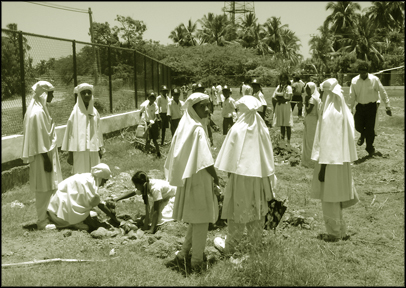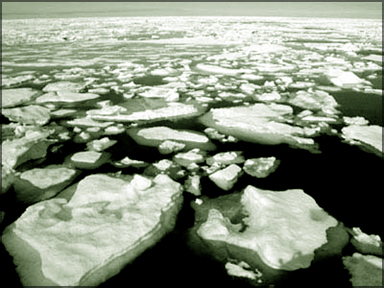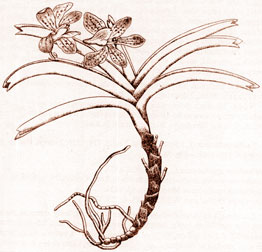Earth hope
`Never dump garbage into water’:
Not just a name change
by Sajitha PREMATUNGE
Marine environment covers more than 70% of the earth’s surface, its
home to millions of flora and fauna, it’s a principal protein source,
thousands of birds depend on oceans for food, the annual global fish
catch amounts to more than 90 mmt, its medical resources are immense and
above all world oceans are a carbon sink.
In the Sri Lankan context its
contributions to national economy is unparalleled, in the form of
fisheries 90%, Protein source 65%, aquaculture, tourism (hotels) 70% and
minerals 100%. Moreover significance of places such as Bonavista Coral
reef, Rekawa Lagoon, Hummane and Hikkaduwa as a sources of immense
aesthetic and biological value cannot be disregarded.
 However environment pollution was not something that bothered humans
until it started to threaten their very existence. Oceans belong to no
one and can’t be demarcated by boundaries, unlike land environments.
Consequently marine environment as opposed to land environment pollution
has started to bother people very recently. However environment pollution was not something that bothered humans
until it started to threaten their very existence. Oceans belong to no
one and can’t be demarcated by boundaries, unlike land environments.
Consequently marine environment as opposed to land environment pollution
has started to bother people very recently.
Marine environment pollution
can be defined as `addition or discharge of a substance or energy by man
deleterious to living resources or human health, hindrance to marine
activities, quality impairment to water usage, reduction of amenities
and amendable to measurement’.
“It is the ultimate dumping yard”, said M.A. Ranjit Kularatne,
Chairman, Marine Environment Protection Authority. “Every human activity
generates waste. Man made waste are often difficult to deal with,
nonbiological compounds” he explained. The greatest threats to oceans
have been identified as land-based sources of marine pollution, over
exploitation of living marine resources, physical alteration or
destruction of marine habitats and the introduction of invasive species
by ship ballast water.
In Sri Lanka roughly 90% of marine pollution is on account of
land-based pollution and only 10% is sea-based. “Most people are
oblivious to this” explained Ranjit Kularatne. He further explained that
our `Ecological Foot Print’ - requirements for survival is greater than
our ‘Biological Capacity’ - what is producible by nature. “The entire
sea area that falls under Sri Lankan territorial waters are protected
under the Maritime Zones Act.”
As a result of this Act the Marine Pollution Prevention Act 59 of
1981 and 35 of 2008 were enacted. As a result of this which was earlier
Marine Pollution Prevention Authority has been renamed Marine
Environment Protection Authority. (MEPA)
But the establishment is eager to prove that this is not just a name
change. Although existing legal backing has proved incapable of
protecting marine environment pollution in the face of new trends of
pollution, the MEPA has made it its priority to reformulate and
implement the National Oil Pollution Contingency Plan, prevent pollution
when engaged in petroleum exploration, establish a proper waste
reception facility for ship generated waste and minimize pollution risk
due to bunkering.
Ranjit Kularatne further explained that the MARPOL 73/78 Convention,
of which Sri Lanka is a signatory, requires for every port to have a
reception facility to extract ship generated waste. “We made a RFP
(Request for Proposals) which ended last Friday for the establishment of
such a facility in Sri Lanka” explained Ranjit Kularatne. He further
explained that the problem of ships’ ballast releasing invasive species
into water is difficult to remedy. More than 7,000 species are
translocated every day through ships’ ballast.
Ballast water is a mechanism used to keep ships afloat, which is
disposed of once new cargo is loaded. “Filtering microorganisms would
prove extremely costly for a country like ours.” He further explained
that as a land-based activity regulatory body the Marine Environment
Protection Authority is trying to do just that with more emphasis on
awareness creation.
“Never dump garbage into water” explained Ranjit Kularatne. “If
everyone with a considerable space of land in Colombo bury their waste
it would probably reduce Colombo’s garbage problem by 30%.”
The chairman of Marine Environment Protection Authority said that he
never issues a ball point pen to a staffer if the empty is not returned.
“We have no right to spend public money irresponsibly.”
Students of St. Mary’s touch the hearts of
conservationists:
Making trees your partners
 At an age children of Colombo schools are not enthusiastic about
appreciating and even taking it for granted the beauty of the
environment that surrounds them, children of St. Mary’s National School,
Hambantota, joined by fellow students of Zahira College, Bandagiriya
National School, Samoda Gama Vidyalaya, Pallawalla Vidyalaya, got out of
their way to plant trees in the St. Mary’s school ground, March 31. At an age children of Colombo schools are not enthusiastic about
appreciating and even taking it for granted the beauty of the
environment that surrounds them, children of St. Mary’s National School,
Hambantota, joined by fellow students of Zahira College, Bandagiriya
National School, Samoda Gama Vidyalaya, Pallawalla Vidyalaya, got out of
their way to plant trees in the St. Mary’s school ground, March 31.
When Sunil Perera, who organised the tree-planting program, suggested
that the school postpone the event till the wet season never thought the
students would offer to water the plants during their vacation! “These
kids deserve more than just a pat on their back for this sort of
dedication.” The students even made the plant covers at home.
But these dedicated children were then, again met with another
obstacle. The area of the school ground was very acrid and difficult to
dig.
But upon seeing the dedication of the children, the Mayor of Matara
hastily made plans to dig the ground with the aid of a backhoe.
Dimuthu Wicramasinghe, a member of YZA (Young Zoologists Association)
who with another member conducted an awareness lecture on site, said
that their objective was not a mere tree planting program, but an
awareness campaign. “The tree planting program was just one aspect.”
 Amon Thuwan, President of the Environmental Society, Faculty of
Agriculture of the University of Ruhuna said that they had transported
150 plants of Halmilla, Pihimbiya, Siyambala, Mara and Ehala from a
Nursery in Weerawila. Amon Thuwan, President of the Environmental Society, Faculty of
Agriculture of the University of Ruhuna said that they had transported
150 plants of Halmilla, Pihimbiya, Siyambala, Mara and Ehala from a
Nursery in Weerawila.
“Our main objective was to build a close relationship among plants
and the students”, explained Amon. “This is the best way to instill love
of nature in children.” He explained that the total responsibility of
each plant is given to a student.
“During the time the trees are under their care they are expected to
keep a record of the tree’s growth and take full responsibility for the
tree.
By the time the student leaves school the tree will be fully grown
and independent,” he explained the forms a strong relationship. “This is
the best way to reform attitudes.”
“My wife always used to say that it would be nice if every kid had
his or her own tree that they could grow up with”, says Sunil Perera
remembering his late wife’s words.
Ice-free arctic ocean possible in 30 years, not 90 as previously
estimated
The amount of the Arctic Ocean covered by ice at the end of summer by
then could be only about 1 million square kilometers, or about 620,000
square miles. That's compared to today's ice extent of 4.6 million
square kilometers, or 2.8 million square miles. So much more open water
could be a boon for shipping and for extracting minerals and oil from
the seabed, but it raises the question of ecosystem upheaval.
 While the Intergovernmental Panel on Climate Change in 2007 assessed
what might happen in the Arctic in the future based on results from more
than a dozen global climate models, two researchers reasoned that
dramatic declines in the extent of ice at the end of summer in 2007 and
2008 called for a different approach. While the Intergovernmental Panel on Climate Change in 2007 assessed
what might happen in the Arctic in the future based on results from more
than a dozen global climate models, two researchers reasoned that
dramatic declines in the extent of ice at the end of summer in 2007 and
2008 called for a different approach.
Out of the 23 models now available, the new projections are based on
the six most suited for assessing sea ice, according to Muyin Wang, a
University of Washington climate scientist with the Joint Institute for
the Study of the Atmosphere and Ocean based at the UW, and James
Overland, an oceanographer with the National Oceanic and Atmospheric
Administration's Pacific Marine Environmental Laboratory in Seattle.
Once the extent of ice at the end of summer drops to 4.6 million
square kilometers -- it was actually 4.3 million square kilometers in
2007 and 4.7 million in 2008 -- all six models show rapid sea-ice
declines.
Averaged together the models point to a nearly ice-free Arctic
in 32 years, with some of the models putting the event as early as 11
years from now.
Environmental News Network
Extinct?
Vanda thwaitesii
Family: Orchidaceae
Scientific Name: Vanda thwaitesii Hook.f.
Status: Extinct, Endemic, protected under
FFPO
 Vanda thwaitesii belongs to the Orchidaceae family (Orchid family)
and was recorded only from the Hunnasgiriya area. Vanda thwaitesii belongs to the Orchidaceae family (Orchid family)
and was recorded only from the Hunnasgiriya area.
It is endemic to Sri Lanka. This species was described using a
painting. It is an epiphytic moderate sized orchid.
The stem of lower area is leafless. The leaves are thick, folded in
middle and the leaf sheath is brown in colour. Characteristic feature of
this species is the fact that this particular species much shorter
leaved than V. tesselata. Flowers are of moderate in size, yellow-green
in colour and are streaked or spotted.
According to the 2007 Red List of Threatened Fauna and Flora of Sri
Lanka Vanda thwaitesii is an extinct species. This species has gone
extinct due to habitat destruction, climate changes, etc...
Reference
Fernando, M., Wijesundera, S. and Fernando, S. (2003) Orchids of Sri
Lanka A Conservationist’s companion. A Simplified Guide to
Identification (Vol:1) The protected orchids and selected similar
species. IUCN, Sri Lanka.
Pic source:
Dassanayake, M.D. and Fosberg, F.R. (eds.) (1981) A revised handbook
to the flora of Ceylon. Amerind, New Delhi.
- Dilup Chandranimal
|

